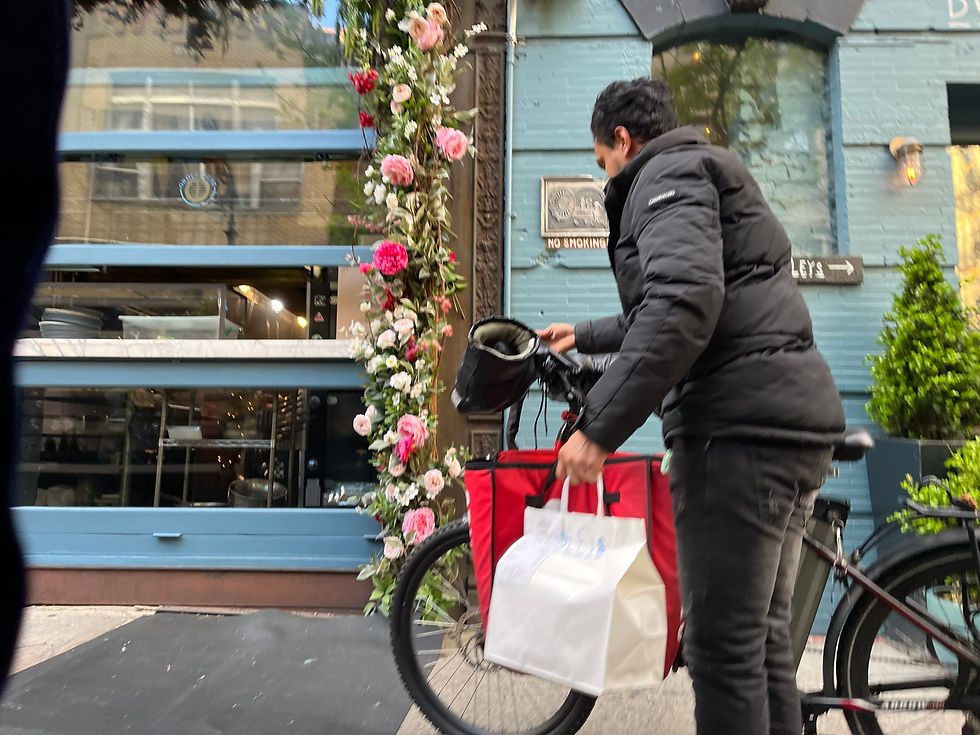FLANEUR-WORKERS //
- Moises Ramirez
- May 1, 2022
- 5 min read
Updated: May 18, 2022
Moises Ramirez //

Flaneur-worker can be seen as the final phase agent of human labor. This can entail a notion of expanded human activity mediated by use of the technological interface, as well as the situated space of the city context with all of its architectural and urban symbolism of necessary circulation. Human worker has still has the ability to say no – what I am terming negative agency. Will the posthuman have the negative agency to decline a service?
The form of the flaneur-worker remains imprinted as a shadow of labor. Since the lockdowns instigated by the pandemic, direct contact is avoided. The anticipation for the arrival of the ordered object is mapped onto the amorphous figure of delivery-worker. The figure of the flaneur-worker stands apart from the socially constituted Other, whom they service. The customer substrate is an algorithmically composed Other who is coded as a number and distance.
What re the conditions for the emergence of the posthuman? Have they been already met? What does posthuman labor look like? Is there an embodied concept of work/labour for the posthuman of the future? Does the posthuman need to rest or will it allow a perpetual status of hesitation from shutdown? Waiting for posthuman to be called into action is a charged potentiality.

Techno-fugue //
A technologically son-ambulant user embedded into dwelling spaces that becomes more isolated and alienated as the passing shadows map themselves onto objects outside. Where did the dependency come for the ambulatory activity of Others for one, the one who works alone, in their remote labors, allow the body to remain in an apartment-confined stasis? How did interacting with a glass surface pane surface become just as real as stepping foot into the circulating waves of random potentialities to be found when leaving the home?

Primitive Interface //
What are the origins of wish-fulfillment mediated through object transformation? Touch-based interfaces today mask their cold surfaces with haptic feedback that simulates living organism’s shiver - an electric and non-human heartbeat. In everyday life, one finds themselves confronted by limits of windows from their objects displayed as desirable while window-shopping. The separation produces an innocuous demand due to immediate its in-attainability. Rather than for the hands to learn a technique and acquire resources to produce for oneself, the glass surface acts as a see-through barrier, allowing imagination idealize the future relation to the object-to-be-possessed. Contact and contact-less interactions have been morphing, but the threat of viral transmission imposes and necessitates distance from the Other - an obliteration of the Other who is to be recomposed as a digital residue without a manifest and material presence.

Negative Agency //
A resistance to alienation may be met with withdrawal and disavowal on the part of the flaneur-worker. The delivery-worker has the option to work 24/7, so long as the zone offers establishments that remain open. During this time of apprehensive potentiality, the worker is free to roam the urban streets, or hover nearby hot-spots. Heat maps on the interface inform the optimal geo-spatial positioning for incoming orders. Once a order is received, the agent has to choose to accept. It is precisely during this moment, that the worker can choose against fulfilment of the Other's desire. Since a dehumanization has occurred, the customer appears as a distance and potential tip, which the worker can assess to take or not. Attributing worth and value to weigh the action is fundamental human aspect of this exchange. A drone would have no choice but to simply perform the request.
Desire detection & processing //
Object Recognition
i) The object may appear in the virtual format of a resemblance of the original, an imitation on the screen of an actual object in the Real.
ii) Language may facilitate the process of designating and assigning formal definitions to representations of the real objects that are desired.
Subject (un)recognition
i) There is a disavowal of the Other through a refusal or reluctance to encounter face-to-face in the World. Social distancing practices and lockdown restraints encouraged a separation of bodies.
ii) Contact-free delivery promotes a mutual dehumanization between the parties.
Object-hood validation
i) A touch-screen offers haptic feedback in granting a sense of material condition or thing-hood aspects/attributes to virtual images on the screen.
ii) Organizing and bundling of multiple units under a single code, the objects are bound together as deliverable object.
Subject-hood validation
i) The worker is validated by the customer through the tipping/rating systems. The consumer is validated by the flaneur-workers acceptance of the order. The restaurant can also be validated through such a rating system by both the worker and the consumer.
ii) The imprint of the labor (i.e. the delivery of the object desired) can be left as a photographic presence that is reported to the company.

Automation / Para-Agency //
Para-agency can be thought of as an enhancement of processing or cognitive abilities of self-management, or regulation of everyday properties.
Stereo-ontology //
Following the research of stereoptics, the flaneur-worker experiences the world in two dimensions: the real-dynamism of the world before the eyes, but also the movement of the avatar-representation within the virtual map of the city. One eye on the world, one eye on the interface. Cognition is split between the processing of the sensual world and following the GPS directions provided by the interface. The dynamic defining one's self in relation to the world mediated through real-time visual processing of the world-at-hand and the virtual rendering as presence on a screen, i.e. via the virtual representation of the self as moving/static object on the screen.

The acousmatic presence of father’s arrival //
A classmate (B) once described how his father would always ring the doorbell to signify his arrival home, even though he had keys of his own. Often the father returns - the child may ask but from where? (perhaps the space of labor/market/war) – with shopping bags full of food which he is providing sustenance for the family, or at war providing a secure future for all inhabitants of the nation-family. But what of this acousmatic1 presence – the sound whose origin is not immediately seen – of the father? LaBelle (2018) states, “the acousmatic… situates us within a complex space by which recognition is shaped less through visual identification and face-to-face relation, but rather through a concentrate appeal to the listening sense.”2 What does it mean for the child to anticipate and wait for the father to arrive to signal his return via the hidden qualities of his sonic presence? These interactions may be establishing a relationship of substitution mediated through primitive interfaces that are not computational, but rather are organic interfaces in the world co-inhabited by forms of simple electrical technology such as a doorbell buzzer, or even a physical knock on the door.
What does the child imagine “work” or “war” means in understanding his father’s removed presence? Labor and war split the father from the family, instituting an anticipation for a future arrival. In the past, postcards and letters home served as reminders of continued living presence at the time of recording/sending. Today, telephone calls, text messages, or an Instagram story update can satiate tee curious surveillance appetite for constant feedback of ensured presence/return. Abandonment anxiety is momentarily forestalled with the haptic feedback of arrival/return.
1 LaBelle, Brandon. Sonic Agency, p. 32.
2 Ibid, (p.33).

Hesitant Nomodology //
Nomadic inter-presence of the agent between the Other's (customer) household and space of object production (restaurant). Operates in a latent space between hesitation and performance, shifting from potential into actual through proximity to the Other's desire-object.



If you want storage that feels premium, MasterStorage365 delivers. https://www.masterstorage365.com/ climate-controlled spaces give me peace of mind for sensitive documents, and the drive-up option is a lifesaver during busy days. The retail center has saved me from last-minute packing emergencies, and their conference room is a professional space I’m proud to host meetings in.